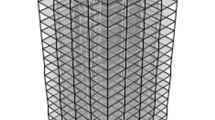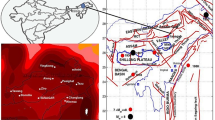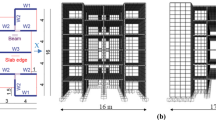Abstract
Recent studies on assessment of a very low annual probability of exceeding (APE) ground motions, 10−4 or less, have highlighted the importance of the upper bound of ground motions when very low probability results are acquired. The truncation level adopted in probabilistic seismic hazard analysis (PSHA) should be determined by an aleatory uncertainty model (i.e., distribution model) of ground motions and the possible maximum and minimum ground motion values of a specific earthquake. However, at the present time, it is impossible to establish the upper bound model for ground motions based on the source characteristics and/or ground motion propagation. McGuire suggested a truncation level be fixed at a number of ɛ = 6, or the distribution of residuals be truncated in such a manner that site intensity cannot be greater than the epicenter intensity. This study aims to find a reasonable and feasible truncation level to be used in PSHA when the physical mechanism is not available to find the extreme ground motion. A mathematical analysis of the influence of the truncation level on PSHA, case studies of sites in different seismotectonic settings, and a distribution analysis of ground motion residuals are conducted in this study. It is concluded that ɛ = 4 is the minimum acceptable value for engineering applications for APEs within 0.002 to 10−4, and for low APEs, such as 10−5 and 10−6, the value of ε should be no less than 5 in most regions of China.
Similar content being viewed by others
References
Abrahamson NA, Birkhauser P, Koller M, Mayer-Rosa D, Smit P, Sprecher C, Tinic S and Graf R (2002), “PEGASOS—A Comprehensive Probabilistic Seismic Hazard Assessment for Nuclear Power Plants in Switzerland,” Proc. of the 12th European Conf. on Earthquake Engineering, London, UK, 9–14 September 2002, Paper No. 633.
Bommer JJ, Abrahamson NA, Strasser FO, Pecker A, Bard PY, Bungum H, Cotton F, Sabetta F, Scherbaum F and Studer J (2004), “The Challenge of Defining Upper Bounds on Earthquake Ground Motions,” Seimol. Res. Lett., 75(1): 82–95.
Bommer JJ and Scherbaum F (2005), Capturing and Limiting Ground Motion Uncertainty in Seismic Hazard Assessment, in Future Directions of Strong Motion Instrumentation, P Gulkan and JG Anderson (Editors), Dordrecht: Springer, pp. 25–40.
Cornell CA (1968), “Engineering Seismic Risk Analysis,” Bull. Seism. Soc. Am., 58: 1583–1606.
Electric Power Research Institute (EPRI) and U.S. Department of Energy (DOE) (2006), “Program on Technology Innovation: Truncation of the Lognormal Distribution and Value of the Standard Deviation for Ground Motion Models in the Central and Eastern United States,” Report 1013105.
Kiureghian AD and Ang A H-S, (1977), “A Fault-rapture Model for Seismic Risk Analysis,” Bull. Seism. Soc. Am., 67: 1173–1194.
Lu Shoude (2006), Textbook for Evaluation of Seismic Safety for Engineering Sites (GB 17741-2005), Beijing: China Standard Press, pp. 85–86. (in Chinese)
McGuire RK (1976), Fortran Computer Program for Seismic Risk Analysis, U.S. Geol. Surv. Open-File Rept. pp.76–67.
McGuire RK (1977), “Effects of Uncertainty in Seismicity on Estimates of Seismic Hazard for the East Coast of the United States,” Bull. Seism. Soc. Am., 67: 827–848.
Stepp JC, Wong I, Whitney J, Quittemeyer R, Abrahamson N, Toro G, Youngs R, Coppersmith K, Savy J, Sullivan T and Yucca Mountain PSHA Project Members (2001), Probabilistic Seismic Hazard Analyses for Ground Motions and Fault Displacements at Yucca Mountain, Nevada, Earthq. Spectra, 17(1): 113–151.
Strasser FO and Bommer JJ (2005), “Preliminary Simulations with EXWIM: Calibration and Assessment of Ground-motion Variability in the Near-source Region,” Research Report 05-002-SM, Department of Civil and Environmental Engineering, Imperial College London, http://www.imperial.ac.uk/civilengineering/research/researchnewsandreports/researchreports.
Strasser FO and Bommer JJ (2009a), “Large-amplitude Ground-motion Recordings and Their Interpretations,” Soil Dyn. Earthq. Eng., 29(10): 1305–1329
Strasser FO and Bommer JJ (2009b), “Review: Strong Ground Motions—Have We Seen the Worst?,” Bull. Seismol. Soc. Am., 99(5): 2613–2637.
Strasser FO, Bommer JJ and Abrahamson NA (2008), “Truncation of the Distribution of Ground-motion Residuals,” J. Seism., 12(1): 79–105.
Strasser FO, Abrahamson NA and Bommer JJ (2009), “Sigma: Issues, Insights and Challenges,” Seism. Res. Lett., 80(1): 41–56.
Tsai CC and Peter (1998), “Engineering Ground Motion Modeling in the Near-source Regime Using the Specific Barrier Model for Probabilistic Seismic Hazard Analysis,” Pure and applied Geophysics, 152: 107–123.
U.S. Nuclear Regulatory Commission (2007), “A Performance-based Approach to Define the Site-specific Earthquake Ground Motion (RG1.208),” Paper No. 8.
Youngs RR, Abrahamson NA, Makdisi F and Sadigh K, (1995), “Magnitude Dependent Dispersion in Peak Ground Acceleration,” Bull. Seism. Soc. Am., 85: 1161–1176.
Yu Yanxiang (1999), “Attenuation Relation of Ground Motions, Evaluation Report of Seismic Safety for Haiyang Nuclear Power Plant in Shandong Province,” Research Report, Institute of Geophysics, China Earthquake Administration, No.98F03008, pp. 249–269. (in Chinese)
Yu Yanxiang (2005), “Attenuation Relation of Ground Motion Parameters — Review and Determination of SL-2 Design Basis Ground Motion for Yangjiang Nuclear Power Plant in Guangdong Province,” Research Report, Institute of Geophysics, China Earthquake Administration, No. 05FC3004, pp. 79–96. (in Chinese)
Author information
Authors and Affiliations
Corresponding author
Additional information
Sponsored by: Program of Seismic Ground Motion Parameter Zonation Map of China; the Basic Research Fund of the Institute of Geophysics Under Grant No. DQJB11C18; the Special Funds for Science and Technology Research Under Grant No. 200708003.
Rights and permissions
About this article
Cite this article
Wu, J., Gao, M., Chen, K. et al. Discussion on the influence of truncation of ground motion residual distribution on probabilistic seismic hazard assessment. Earthq. Eng. Eng. Vib. 10, 379–392 (2011). https://doi.org/10.1007/s11803-011-0074-0
Received:
Accepted:
Published:
Issue Date:
DOI: https://doi.org/10.1007/s11803-011-0074-0




